Taipei arts program helps children develop sense of aesthetics
By Yali Chen But the arts should be embedded in the teaching of all subjects as a way of cultivating creativity and imagination in schoolchildren, says a paper published in January 2011 by the Australian Council for Educational Research. According to the paper, students who are exposed to the arts achieve better academic results, are more engaged at school are less likely to leave early, and have better self-esteem than students who do not have access to the arts. In addition, exploration of art can help students develop an eye for aesthetics. To help build their awareness of art and aesthetics, the Taipei City Government launched an arts program for children aged 9 to 12 in 2005. "Organized by the departments of education and cultural affairs, this initiative has integrated art into core courses," says Liu Wei-gong, Director of the Taipei Department of Cultural Affairs. The number of schoolchildren participating in this project each year is expected to range from 90,000 to 110,000. Under the policy, third-graders visit the Taipei Fine Arts Museum and fourth-graders watch children's drama at the Taipei Cultural Center. Students in fifth- and sixth-grade attend concerts held by the Taipei Symphony Orchestra and the Taipei Chinese Orchestra respectively. Liu notes that in the first half of this year children at the age of 8 begin to take part in the program by visiting the Puppetry Art Center of Taipei and Lin Liu-hsin Puppet Theatre Museum. "The city government views cultural rights as an inalienable part of human rights," says Guo Pei-yu, an administration official in charge of this initiative for the Taipei Department of Cultural Affairs. "We hope that schoolchildren will be exposed to art and culture through visits to museums and art galleries, as well as through theater and concert performances." Puppet shows always capture young children's interest, stimulating their imagination and creativity. The Puppetry Art Center of Taipei is ideal for preschoolers and students under 8, its manager Lin Jia-yu says, adding that like the Lin Liu-Hsin Puppet Theatre Museum, the center will give 90 performances this year. The center is divided into four areas: glove puppets, string puppets, shadow puppets, and interactive games. It also offers children DIY puppetry classes, teaching them how to make simple hand puppets and rod puppets from materials available in everyday life. Teachers, students and families with young children are encouraged to take advantage of the Puppetry Art Center and its wide array of puppet exhibitions, performances, interactive games and guided tours. "We will guide second-graders and their teachers through our traditional puppet collections, telling interesting stories to help them better understand the history of glove, string, shadow, and rod puppets," center manager Lin notes. After watching a 40-minute puppet show titled "Journey to the West: Sun Wukong's Battle against Red Boy," participants are also encouraged to perform on stage by manipulating a puppet's hands and feet. Popular among young children, Sun Wukong, also known as the Monkey King, is one of the main characters in the classic Chinese epic novel. A relentless promoter of Taiwanese culture, Lin Ching-fu established the TTT Puppet Centre in 2000 with Robin Ruizendaal, who has dedicated most of his adult life to studying puppet drama in China and Taiwan. In November 2005 the TTT Puppet Centre moved to a permanent residence generously donated by Lin's mother. In memory of his father Lin Liu-hsin, he renamed the centre Lin Liu-hsin Puppet Theatre Museum. With a collection of over 6,000 pieces acquired from all over the world, the museum includes four floors of exhibitions and the Nadou Theatre designed for small-scale performances such as puppets, music, dance and theater. In addition to eye-opening puppet shows, it also offers workshops including puppet carving, puppet-master demonstrations, and traditional puppet techniques. On the fourth floor and roof garden, one special exhibition titled "Water World: Vietnamese Water Puppets" presents more than 30 precious Vietnam water puppets from the 1950s to the present. Visitors can try coordinating a Vietnamese water puppet's hands and feet themselves. "Since 2001 the Taipei-based museum has staged art exhibitions for children's art education," says Liu Chien-kuo, TFAM's Chief of the Education Department. One art exhibition, named "KoKo: From Nature to Art," which was shown from December 2010 to May 2011, was designed for families. Twelve oil paintings on display at the exhibition included early Taiwanese landscape paintings by artists Yang San-lang, Liao Te-cheng, Ho Te-lai, Ma Pai-sui, Hsi-Te-chin, Chu Teh-chun, Lu Chi-cheng, Li Che-fan, Lin Tien-jui, Gao Yeh-jung, Cheng Shih-fan, and Yang Qi-dong. Through these artworks, children can explore the beauty of art and learn how artists use different ways to depict colors, neighborhoods, the countryside, mountains, famous sites and scenic spots on their canvases. The museum also uses hands-on interactive devices to help parents and kids develop their observation skills and reexamine their everyday life from an artistic point of view. In 2011 a total of 6,010 seventh-grade teachers and students from 16 schools in Taipei attended Peking opera performances by the Guo Guang Opera Company. The company arranged two traditional works, "Stopping the Horse" and "The Match of He-zhu," for teenagers. The former highlights kungfu, stunts, gongs and drumbeats. Veteran actors use a table and two chairs to display brilliant techniques, pretending to ride a horse by waving a whip on stage. The latter features a light comedy incorporating pop music and Taiwanese snacks such as oyster omelet and egg-fried rice into the original version of the work.
STAFF REPORTERArt education in Taiwan is receiving less attention from primary and junior high school students, teachers, and parents these days because of increasing academic pressure on students. In many local schools the arts and humanities have been pushed to the fringe.
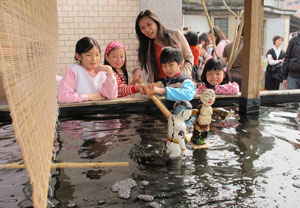 To allow more students to benefit from this plan, the city government asked the Guo Guang Opera Company to give performances to seventh-grade students in the second half of 2011.
To allow more students to benefit from this plan, the city government asked the Guo Guang Opera Company to give performances to seventh-grade students in the second half of 2011.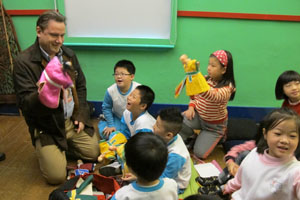 In 1998, Lin Ching-fu, Chairman of the Taiyuan Arts and Culture Foundation, donated a collection of his puppets that he had gathered over several decades to the city government. Intended as a venue for exhibition, performance, teaching, and collection of these puppets, the Puppetry Art Center Taipei opened on August 7, 2004, next to the CPCity Living Mall – the biggest shopping mall in East Asia.
In 1998, Lin Ching-fu, Chairman of the Taiyuan Arts and Culture Foundation, donated a collection of his puppets that he had gathered over several decades to the city government. Intended as a venue for exhibition, performance, teaching, and collection of these puppets, the Puppetry Art Center Taipei opened on August 7, 2004, next to the CPCity Living Mall – the biggest shopping mall in East Asia.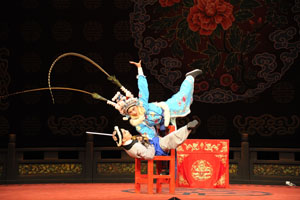 "During the show some kids were so excited that they screamed and leapt from their seats," she laughs.
"During the show some kids were so excited that they screamed and leapt from their seats," she laughs.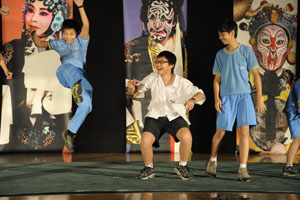 Taipei Fine Arts Museum provides third-grade students with a wide variety of exhibitions such as oil painting, sculpture, watercolor painting, Chinese brush painting, contemporary art, design, architecture, and installation art.
Taipei Fine Arts Museum provides third-grade students with a wide variety of exhibitions such as oil painting, sculpture, watercolor painting, Chinese brush painting, contemporary art, design, architecture, and installation art.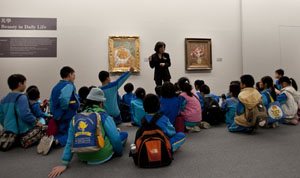 "The family-friendly devices were popular among young children who had a great time at the museum," Liu says, adding that they also liked Taipei Biennial thanks to its wide assortment of contemporary artworks and creative media.
"The family-friendly devices were popular among young children who had a great time at the museum," Liu says, adding that they also liked Taipei Biennial thanks to its wide assortment of contemporary artworks and creative media.

![Taiwan.gov.tw [ open a new window]](/images/egov.png)
